 With high interest, and lack of ammo or cases, it is often necessary to make your own cases for some of the oldies. A good example is the Winchester family of self loading rifles that came out about a hundred years ago. None of the ammo or rifles are produced today. I am referring to the .32, .35, .351 and .401 Winchester self loaders. They were fairly popular for some years, especially the two larger calibers. France and Russia used them to an extent in WWl and they were use by prison guards and various police forces for a number of years.
With high interest, and lack of ammo or cases, it is often necessary to make your own cases for some of the oldies. A good example is the Winchester family of self loading rifles that came out about a hundred years ago. None of the ammo or rifles are produced today. I am referring to the .32, .35, .351 and .401 Winchester self loaders. They were fairly popular for some years, especially the two larger calibers. France and Russia used them to an extent in WWl and they were use by prison guards and various police forces for a number of years.
Brass can be made for them, but you need some equipment, a lathe being the best implement for this work. If you don’t have a lathe, and can’t buy one, then contact a machinist, perhaps you can get him to do it for you. Just give him the specs. Since the procedures are the same I am going to cover the three smaller ones and treat the 401 differently.
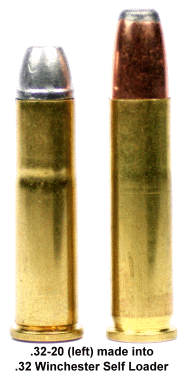 The 32 WSL is made from a 32-20 case that is taper expanded out and trimmed to length. The length is 1.28 after trimming and chamfering. Anytime you trim a case be sure to chamfer it both inside and out to facilitate seating the bullet. Most makers of reloading dies make a chamfer tool. The same tool can be used for both the inside and outside. Just put it on or in the case and turn it a few tines to get the excess brass removed. The rim has to be turned down about .020 from .408 of the original case to .388. The rim thickness might have to be reduced from about .064 to .055. The head diameter might have to be reduced from .353 to 346 but the sizing die should do that. You also have to cut an extractor groove in it to facilitate extraction as it is technically a semi-rimmed cartridge. When cutting the groove be sure not to remove excess material or you will weaken the case. I would start with a .010 groove and go from there. Cut it just deep enough so it will function without weakening the case. If you have the rifle there you might be able to tweak the specs a little because of the age and the dimensions of the rifle might be sloppy. You can use a .321 diameter bullet made by Hornady or Speer. A cast bullet will also work fine in this rifle.
The 32 WSL is made from a 32-20 case that is taper expanded out and trimmed to length. The length is 1.28 after trimming and chamfering. Anytime you trim a case be sure to chamfer it both inside and out to facilitate seating the bullet. Most makers of reloading dies make a chamfer tool. The same tool can be used for both the inside and outside. Just put it on or in the case and turn it a few tines to get the excess brass removed. The rim has to be turned down about .020 from .408 of the original case to .388. The rim thickness might have to be reduced from about .064 to .055. The head diameter might have to be reduced from .353 to 346 but the sizing die should do that. You also have to cut an extractor groove in it to facilitate extraction as it is technically a semi-rimmed cartridge. When cutting the groove be sure not to remove excess material or you will weaken the case. I would start with a .010 groove and go from there. Cut it just deep enough so it will function without weakening the case. If you have the rifle there you might be able to tweak the specs a little because of the age and the dimensions of the rifle might be sloppy. You can use a .321 diameter bullet made by Hornady or Speer. A cast bullet will also work fine in this rifle.
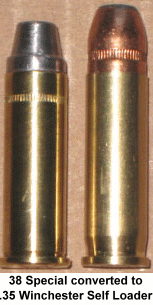 The 35 WSL has the same procedures as the 32 meaning that a lathe is the best tool to make quality cases. You can use a 38 special case to start the project with. You will trim the case to 1.14 and chamfer the case mouth. The rim should be turned to .405 then thin the rim to .05. Like the 32 an extractor groove needs to be cut to insure proper functioning. The groove should be cut so that the extractor fits over the head without excess brass being removed. The head diameter is .380. You need the correct sizing die as the bullet diameter is .351. I don’t recommend 356 or 357 diameter bullets as they will probably cause difficult chambering and excess pressures. Like the 32 you might be able to adjust some of the dimensions slightly to suit your rifle.
The 35 WSL has the same procedures as the 32 meaning that a lathe is the best tool to make quality cases. You can use a 38 special case to start the project with. You will trim the case to 1.14 and chamfer the case mouth. The rim should be turned to .405 then thin the rim to .05. Like the 32 an extractor groove needs to be cut to insure proper functioning. The groove should be cut so that the extractor fits over the head without excess brass being removed. The head diameter is .380. You need the correct sizing die as the bullet diameter is .351. I don’t recommend 356 or 357 diameter bullets as they will probably cause difficult chambering and excess pressures. Like the 32 you might be able to adjust some of the dimensions slightly to suit your rifle.
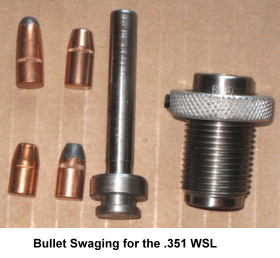 The 351 is the most common of the bunch but you will still have to make your own brass to shoot it. The best case is a 357 maxi which you shorten to 1.38 then chamfer. The rim diameter is turned to .407. An extractor groove also needs to be cut also. Like the 35 WSL you need the correct sizing die as the bullet is .351 which is shared by nothing except its smaller relative the 35. For both of these calibers I swage down 357 bullets and they work fine.
The 351 is the most common of the bunch but you will still have to make your own brass to shoot it. The best case is a 357 maxi which you shorten to 1.38 then chamfer. The rim diameter is turned to .407. An extractor groove also needs to be cut also. Like the 35 WSL you need the correct sizing die as the bullet is .351 which is shared by nothing except its smaller relative the 35. For both of these calibers I swage down 357 bullets and they work fine.
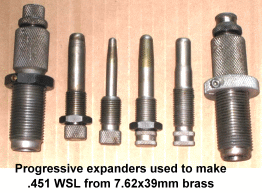 The 401 is the largest of the WSL rifle calibers and is made a little differently. The easiest way to make them is to get a 7.62 X 39 case and straighten it out. Having a taper expander tool comes in handy for this operation. You might want to do it in a couple of steps to avoid splitting the case. I would neck it up to a 35 then finish it in the second step.
The 401 is the largest of the WSL rifle calibers and is made a little differently. The easiest way to make them is to get a 7.62 X 39 case and straighten it out. Having a taper expander tool comes in handy for this operation. You might want to do it in a couple of steps to avoid splitting the case. I would neck it up to a 35 then finish it in the second step.
Another way to avoid splitting is to anneal the case. To do that, place them in a pan of water up to near the bottom of the neck. Putting water in the pan is critical because if you overheat the head of the case it will weaken it making it unsafe to shoot. Heat the case all around evenly to a dark cherry red and let cool using a propane torch. That makes the necks more malleable thus less likely to split. An old cake pan makes is an excellent receptacle for performing that chore. After doing that trim and chamfer and you should be in business.
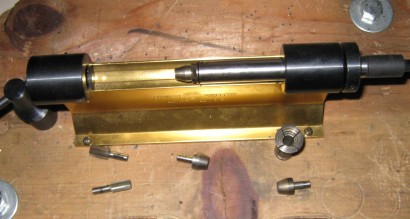 For trimming I use a Forrester case trimmer with a drill attached which has served me well for more years and cases then I care to admit to. The length is 1.50” while the head diameter is .429. It does have a rim that protrudes from the body sporting a diameter of .457”. If you like to do more work there is the 35 Remington case. You would trim to length and would probably be obligated to ream out the inside of the case as it may be too thick to seat the bullet. Otherwise the procedures are about the same. In a pinch you can use a 9.3 X 72 or 30-30 cases but both of them require more steps and aren’t worth the work involved. The 7.62 X 39 case is still inexpensive and plentiful and that’s what I use. In spite of it’s smaller rim of .443 it works well every time I used it. Proper bullet diameter is .408 which is available from various sources or swage down a 41 magnum bullet.
For trimming I use a Forrester case trimmer with a drill attached which has served me well for more years and cases then I care to admit to. The length is 1.50” while the head diameter is .429. It does have a rim that protrudes from the body sporting a diameter of .457”. If you like to do more work there is the 35 Remington case. You would trim to length and would probably be obligated to ream out the inside of the case as it may be too thick to seat the bullet. Otherwise the procedures are about the same. In a pinch you can use a 9.3 X 72 or 30-30 cases but both of them require more steps and aren’t worth the work involved. The 7.62 X 39 case is still inexpensive and plentiful and that’s what I use. In spite of it’s smaller rim of .443 it works well every time I used it. Proper bullet diameter is .408 which is available from various sources or swage down a 41 magnum bullet.
After you make these case which can be somewhat labor intensive what should you expect? If the cases are properly processed they will last a number of firings. Once made you just follow standard reloading procedures and you can enjoy a part of history for a long time. While they are not the most accurate rifle in the tool shed they are fun to shoot and don’t kick much. After all don’t we shoot for fun? Reloading data for all of them can be found in Cartridges of the World.

Email Notification